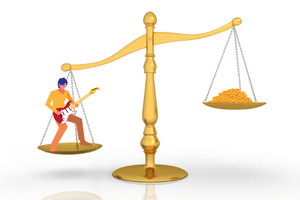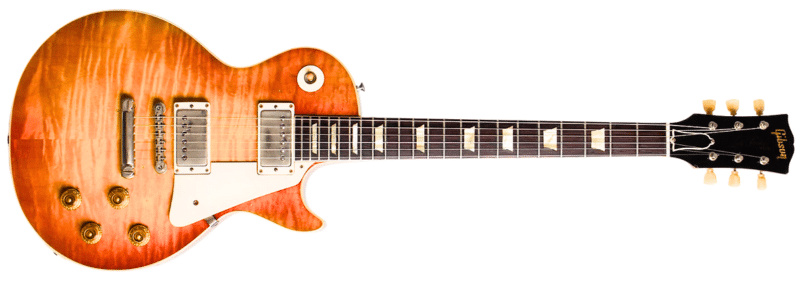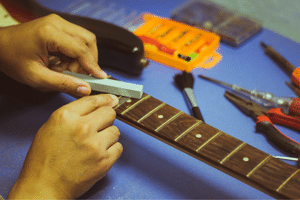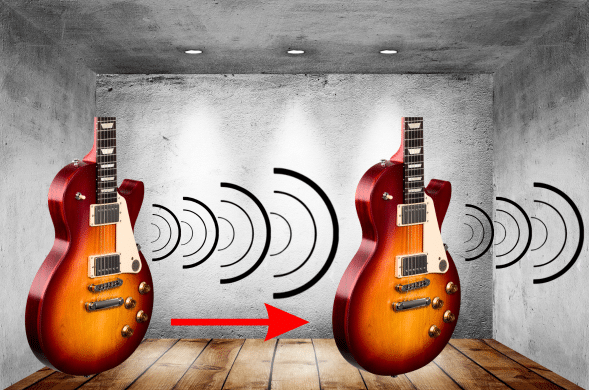Every guitarist knows that the secret to a great sound isn’t just about the notes you play; it’s also about how long those notes linger in the air. In this article, I’ll reveal how to reduce sustain on an electric guitar and how your amplifier and effects pedals can help.
If you’re looking to tighten up your sound and add a punchier, more rhythmic quality to your playing, then read on!
You can use the table of contents below to take you to the area that interests you. Click on the little box to open it, and then click on the section of the article you want to read, or you can read from start to finish if you want the full guitar experience!
The Short Answer
Reducing sustain on an electric guitar involves adjustments to your guitar’s setup, changes in your playing technique, tweaking your amplifier settings, and using effects pedals. Each of these methods offers unique ways to control your guitar’s sustain, allowing you to customize your sound to suit your style.
Keep On Reading (Below) To Learn More
Understanding Sustain
Sustain refers to the period that a musical note remains audible after being played. On an electric guitar, sustain is influenced by several factors, including the guitar’s construction, the type of strings used, the playing technique, and the use of amplifiers and effects pedals.
While a long sustain can be desirable for certain styles of music or specific parts of a song, there are times when a shorter sustain is more appropriate.
Why Would You Want to Reduce Sustain?

Reducing sustain can help you achieve a cleaner, more precise sound, particularly when playing complex chords or fast passages.
Less sustain can also be beneficial when playing rhythm guitar, as it helps to keep the rhythm tight and prevents the sound from becoming muddy.
Additionally, certain playing techniques, such as palm muting, may require a reduction in sustain to achieve the desired sound.
Of course, there are pros and cons to using guitar sustain. In reality, the idea is not to totally eliminate it. Like anything else, you want just the right mix in your playing; not too much, but not too little.
Check out the table below for more information,
Pros And Cons Of Using Guitar Sustain


This table gives five reasons why using too much sustain can hurt your sound.
| Pros Of Using Guitar Sustain | Cons Of Using Guitar Sustain |
|---|---|
| Enhanced Musical Expression: Sustain can add emotion and depth to your playing, allowing notes to ring out and create a more expressive sound. | Potential for Muddiness: Too much sustain, especially in complex chord progressions or fast passages, can cause notes to overlap and create a muddy sound. |
| Increased Note Duration: Sustain allows a note to ring out for a longer period, which can be useful for certain musical styles and techniques. | Requires Control: Managing sustain, especially when using effects or amplifiers, requires skill and control to prevent unwanted noise or feedback. |
| Versatility In Sound: Sustain can be manipulated to create a variety of sounds and effects, making it a versatile tool in a guitarist’s arsenal. | Can Mask Technique: Over-reliance on sustain can sometimes mask poor technique, as it can cover up mistakes or inaccuracies in playing. |
| Creates Atmosphere: Long sustain can create a sense of atmosphere or space in the music, particularly in genres like ambient or post-rock. | May Not Suit All Genres: High levels of sustain may not suit all genres, especially staccato runs or where a tighter, more percussive sound with less sustain might be preferred in punk or certain types of metal. |
| Facilitates Legato Playing: Sustain is essential for smooth legato playing, where notes are connected in a seamless flow. | Equipment Dependency: Achieving high levels of sustain often depends on specific equipment, such as certain guitars, amplifiers, or effects pedals. |
As with many aspects of music, the effective use of sustain often comes down to the skill of the musician and the specific demands of the music being played.
Techniques To Reduce Sustain
Here’s a quick summary of all the ways a guitar player can reduce sustain.
| Method | How to Reduce Sustain |
|---|---|
| Adjusting Your Guitar’s Setup | Lower the action, use lighter strings, use a bridge and nut made of softer materials |
| Playing Techniques | Use palm muting, play staccato |
| Adjusting Your Amplifier | Lower the gain/drive, adjust the EQ settings |
| Using Pedals and Effects | Use a compressor pedal with a fast attack time, use a noise gate pedal |
Keep On Reading (Below) To Learn More
Adjusting Your Guitar’s Setup
The way your guitar is set up can have a significant impact on its sustain. Here are a few adjustments you can make to reduce it.
- Action: Lowering the action (the height of the strings above the fretboard) can reduce sustain. However, be careful not to lower it too much, as this can cause fret buzz.
- Strings: Lighter gauge strings tend to have less sustain than heavier ones. Strings made from certain materials can also reduce sustain (see below).
- Pickups: Raising the height of the guitar pickup can reduce sustain because it increases the magnetic pull on the strings, and they vibrate for less time.
- Bridge and Nut: The materials used for the bridge and nut can affect sustain. Materials that are harder and denser (like metal or bone) tend to increase sustain, while softer materials (like plastic) can reduce it.
Examples Of String Types And Their Effect On Sustain
- Nickel-Plated Steel Strings: These are the most common type of electric guitar strings. They provide a balanced tone with good sustain, but not as much as pure nickel strings.
- Stainless Steel Strings: These strings are known for their bright and crisp tone. They generally have less sustain than nickel or nickel-plated strings.
- Coated Strings: Strings that are coated (such as those by brands like Elixir) can sometimes have slightly less sustain than uncoated strings. The coating that helps the strings resist corrosion can also dampen the vibrations a bit.
- Light Gauge Strings: Regardless of the material, lighter gauge strings tend to have less sustain than heavier ones. This is because they have less mass to keep vibrating after the string is plucked.
- Guitar Pick: A thicker or harder pick can increase sustain by striking the strings more forcefully.
Remember, the type of strings you choose should depend on the style of music you play and your personal preference. It’s always a good idea to experiment with different types of strings to find the ones that best suit your needs.
Playing Techniques
The way you play the guitar can also influence sustain. Here are a couple of techniques to try.
- Palm Muting: This technique involves resting the palm of your picking hand on the strings near the bridge while you play, which dampens the sound and reduces sustain.
- Staccato Playing: This involves playing notes in a short, detached manner, which naturally reduces sustain.
Adjusting Your Amplifier
Your amplifier settings can also affect sustain. Here’s what you can do to reduce it.
- Gain/Drive: Lowering the gain or drive on your amplifier can reduce sustain. High gain settings increase sustain, so turning it down can have the opposite effect.
- Equalization (EQ): Adjusting the EQ settings on your amplifier can also affect sustain. Cutting the mid frequencies and boosting the highs and lows (a “scoop” EQ setting) can reduce sustain.
Using Pedals And Effects
Certain effects pedals can help reduce sustain:
- Compressor Pedals: While these are often used to increase sustain, setting a fast attack time on a compressor pedal can help to reduce sustain by quickly lowering the volume after the initial attack of the note.
- Noise Gate Pedals: These pedals cut off the sound once it falls below a certain volume, effectively reducing sustain.
Tips For Controlling Sustain

Controlling sustain is all about balance. Here are some tips to keep in mind.
- Experiment: Try different combinations of setup adjustments, playing techniques, amplifier settings, and effects to see what works.
- Context is Key: The right amount of sustain depends on the musical context. What works for a slow blues solo might not work for a fast punk rock rhythm part.
- Practice: Like any aspect of guitar playing, controlling sustain takes practice. Spend time experimenting with different techniques and settings to find what works best for you.
What About Guitar Weight

The weight of an electric guitar can indeed influence its sustain, but it’s important to note that this is a topic of ongoing debate among guitarists and luthiers.
Many players and luthiers believe that heavier guitars, often made from denser woods like mahogany or maple, tend to offer more sustain. The theory behind this is that a heavier body has more mass, which can absorb the energy of the vibrating strings. As a result, more of the string’s energy is preserved, which can lead to longer sustain.
If you’ve ever played a Les Paul guitar, you will agree that its weight definitely adds to its natural sustain.

On the other hand, there are also proponents of lighter guitars, typically made from woods like alder or basswood. These individuals argue that while the guitar’s body contributes to the overall tone and sustain, it’s just one factor among many. Other elements, such as the guitar’s construction, the type of neck joint, the hardware, and even the player’s technique, can all significantly influence sustain.
Another aspect to consider is the guitar’s resonance and vibration. Some players believe that lighter guitars have a certain “liveliness” due to the way they resonate, which can affect the perception of sustain.
Key Takeaways

Here are three things to remember when using sustain in your playing.
- Reducing sustain can help achieve a cleaner, more precise sound.
- The right amount of sustain depends on the musical context.
- Experiment with different techniques and settings to find what works best for you.
Are You Qualified To Make Guitar Adjustments Or Modifications?

It’s great to work on your guitars, especially if you have a lot of them, but you should always be aware of your limitations.
Adjusting things like an electric guitar’s string height (action) or pickup height can be straightforward. Still, some adjustments require the proper training and experience, like adjusting a guitar’s truss rod.
When you doubt your ability to adjust, repair, or modify your guitar, it’s always best to bring it to a competent guitar technician or luthier (guitar designer & builder). You can permanently damage your guitar, and it might never play and sound right again!
Making modifications to your guitar can void its manufacturer’s warranty and cause permanent damage to the instrument. Certain modifications are irreversible, so you may be stuck with them, even if you desperately want to restore the guitar to its original condition!
I learned that the hard way over the years until I did a three-year apprenticeship in a guitar repair shop. Now I have my own home workshop with the proper training and equipment to safely maintain and repair all my instruments.
Remember: “When In Doubt, Send It Out!”
Frequently Asked Questions

Here are some of the questions I get asked about guitar sustain.
If your question does not appear here, please put it in the comments, and I will get right back to you with an answer.
Can Intonation Affect Sustain?
No, intonation doesn’t directly affect sustain, although poor intonation can cause dissonance, which might make notes seem like they’re decaying more quickly.
Does Vibrato Increase Sustain?
Yes, Bending the string adds kinetic energy that keeps it sounding (vibrating) for longer periods of time. The faster or wider the vibrato, the longer the note can be sustained.
Do String Through Guitars Have More Sustain?
Yes, generally speaking, guitars with a “string-through-body” design are believed to have more sustain than those where the strings are anchored only at the bridge.
What Is The Role Of The Guitar’s Neck In Sustain?
The material and construction of the neck can greatly influence sustain. Denser woods like maple or mahogany often provide better sustain.
The type of neck joint also plays a role. Set necks and neck-through designs generally offer better sustain than bolt-on necks.
Do Neck Through Guitars Have Better Sustain?
Yes, generally speaking, guitars with a neck-through-the-body design are believed to have more sustain than those with bolt-on or set neck designs.
Do Humbuckers Have More Sustain?
The double-coil design of a humbucker pickup tends to produce a stronger signal, which can lead to more sustain than single-coil pickups.
How Do Temperature And Humidity Affect Sustain?
Extreme temperatures and humidity can affect the guitar’s wood, potentially altering its sustain. It’s best to store guitars in a stable, controlled environment to maintain their optimal condition.
How Long Should A Guitar Sustain?
The length of sustain on a guitar can vary greatly. For an electric guitar, a note struck with vigor might last anywhere from a few seconds to 10-15 seconds or even longer, especially if using effects like compression or overdrive.
Final Thoughts

Understanding how to reduce sustain on an electric guitar involves a comprehensive look at various aspects of your instrument, playing technique, amplifier, and effects pedals.
From the type of guitar and its construction to the strings, pickups, and even the way you play, each element plays a role in shaping the sustain of your guitar.
While sustain is often desired for its ability to add richness and fullness to the sound, there are situations where less sustain is beneficial. Reducing sustain can bring clarity to fast passages, prevent notes from bleeding into each other, and provide a tighter, more percussive sound.
Remember, the goal is not to eliminate sustain entirely but to control it to suit your musical needs. Experiment with different techniques, setups, and equipment to find the right balance. And most importantly, let your ears be the ultimate judge.
Whether you’re a beginner or a seasoned player, I hope this article has provided you with valuable insights into how to reduce sustain on an electric guitar. Happy playing!

Here’s an interesting video from Darrell Braun Guitar, who tests several guitars against a Les Paul Standard for natural sustain. You won’t believe which guitar the winner is! Check it out.
What To Read Next ➡ How To Get More Sustain On Clean Guitar Tone – Pro Insider Tips!
Related Article ➡ Using Guitar Sustain For Different Musical Genres: Best Tips
Tell Me What You Think

Please leave a comment below if you enjoyed this article, have any questions about guitar sustain, or want to give your point of view. I will be happy to help you.
- How do you reduce electric guitar sustain?
- What amplifier EQ settings do you use to help reduce sustain?
- Do you find setting a compressor with a fast attack time useful for reducing sustain?
- What else is on your mind?



Great article! It provides a comprehensive guide on reducing sustain for electric guitars. I found the tips on adjusting the guitar’s setup, using different playing techniques, and tweaking amplifier settings really helpful. The discussion on the pros and cons of sustain was insightful, reminding me of the importance of finding the right balance. The cautionary note about seeking professional assistance for adjustments or modifications was a wise reminder. Overall, this article is a valuable resource for guitarists like me who want to enhance their sound and have better control over sustain. Thanks for sharing!
Hi, Alice
Thank You for your comments!
I’m really happy you found this article helpful and hopefully useful to take your playing to the next level! 😎
Rock On! 🤘
Frank 🎸
Hi there Frank!
I’m really fascinated by the concept of reducing sustain on an electric guitar. I’ve been playing guitar for a little while now, and I’ve noticed that sustain can really affect the overall sound and feel of my playing. However, I’m not entirely sure about the technical aspects of sustain and how to manipulate it. The article you’ve written seems to provide a comprehensive guide on the topic.
I have a question about the different techniques mentioned for reducing sustain. I see that adjusting the guitar’s setup, using different playing techniques, tweaking amplifier settings, and using effects pedals can all contribute to controlling sustain. Among these methods, which one would you recommend for someone like me who’s relatively new to this concept and wants to experiment with reducing sustain in their playing?
Also, are there any specific tips you would offer to someone starting out with these techniques?
Thank you for sharing your expertise on this topic!
Hi, Skamalka
Thank You for your comments!
As a beginner, you can learn to control sustain by using palm muting and controlling your amplifier’s volume and gain settings.
I recommend you set up your guitar to give the best tone and playability, not to reduce sustain. You can turn the guitar volume down to accomplish this.
Keep On Rockin’ 🤘
Frank 🎸